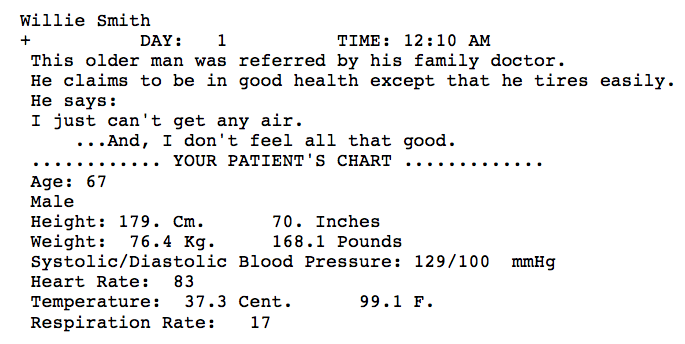We examine the information revealed in HUMAN by selecting < Your Patient's Chart > ...

... noting "tires easily" and that he "can't get enough air."
Case - Tires Easily; Can't Get Any Air
Hints page
I. The Case (& preliminary "hints")
Case - Tires easily; can't get any air
II. The Chart
We examine the information revealed in HUMAN by selecting < Your Patient's Chart > ...
... noting "tires easily" and that he "can't get enough air."
III. The output data table
We note some tendency toward hypertension, both systolic (SBP) and certainly diastolic DBP) and a perhaps elevated respiration rate (RESPRT).
IV. Other
Concentrating first on "can't get any air", we decide to take a blood gas sample and perhaps some respiratory measurements.
A] To obtain a blood gas sample, adding in some basic respiratory measurements
• we check on how to obtain blood gases under Tips:< How do I?>
• we set up our output tables to obtain these and some respiratory values
• we observe the results
B] Observations on the data
We see a patient who is
• markedly hypoxic (arterial PO2 = 63.4 mmHg)
• markedly hypocapnic arterial PCO2 = 28 mmHg) and therefore likely hyperventilating and
• confirm the hyperventialtion (VENT= 10.5 L/M) and high alveolar ventilation (AVENT = 7.8 L/M) via our direct measurements.
C] Note that the same data can be obtained by asking for a Lungs and Ventilation Summary under View: <Patient charts or lab tests>
V. More
This ends the hints section, part 1, on this case.
You should attempt again at this point to arrive at a diagnosis and, where possible, a treatment. To do so
• Return to the HUMAN model's Physiology Lab section for this patient and verify
- the diagnosis by finding the appropriate variables to support your argument and
- the treatment by changing parameters so as to stabilize the patient.
VI. Hints section, part 2
If you wish further hints on this case click the link to the right [ second hint page ]
VII. Analysis
If you wish further analysis and a diagnosis on this case and information on how it was created, click on this link ( analysis ) and log in as requested.
* Note: Case hints and analyses are based heavily on Drs. Randall and Coleman's HUMAN-80 Instructor's Manual supplemented by notes of Dr. Coleman's in the model code itself and findings by myself and other colleagues over our years of use of these cases.